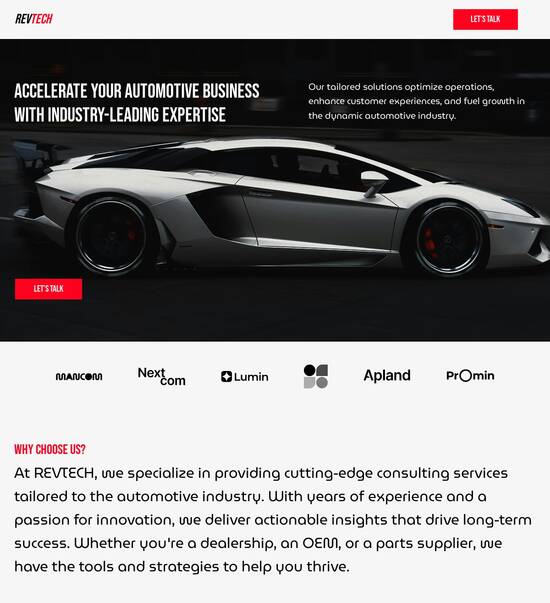
Ruby blog page templates
Explore Similar TemplatesAbout template
Maximize your marketing strategy with ruby blog page templates. Start today and achieve immediate results.
Recommended templates

Easy to build without coding
With the intuitive drag-and-drop builder, anyone on your team can create high-converting pages without any knowledge of code or design. Make enhancements to your landing page with custom widgets using Javascript, HTML/CSS, or third-party scripts.

Multiple layouts for any industry and goal
Select from 500+ landing page layouts built to boost conversions across industry-specific scenarios. Customize them by adjusting fonts, adding images, and generating on-brand content with the AI assistant. Quickly scale with Instablocks® and Global Blocks that you can save, reuse, and update globally.

Loads fast and looks polished on any device
Every template is responsive, which means they present professionally on any device and load blazingly fast with our Thor Render Engine. You can also power them up with Google AMP technology to deliver an unparalleled mobile experience and drive higher conversions.

Robust analytics & experimentation
Get real-time updates and reporting across all your devices, showing the number of visitors, conversions, cost-per-visitor, and cost-per-lead. Launch AI-powered experiments, run A/B tests, and use heatmaps to analyze user behavior, then optimize your landing page to maximize conversions.







Easy to build without coding
With the intuitive drag-and-drop builder, anyone on your team can create high-converting pages without any knowledge of code or design. Make enhancements to your landing page with custom widgets using Javascript, HTML/CSS, or third-party scripts.
Multiple layouts for any industry and goal
Select from 500+ landing page layouts built to boost conversions across industry-specific scenarios. Customize them by adjusting fonts, adding images, and generating on-brand content with the AI assistant. Quickly scale with Instablocks® and Global Blocks that you can save, reuse, and update globally.
Loads fast and looks polished on any device
Every template is responsive, which means they present professionally on any device and load blazingly fast with our Thor Render Engine.
Robust analytics & experimentation
Get real-time updates and reporting across all your devices, showing the number of visitors, conversions, cost-per-visitor, and cost-per-lead. Launch AI-powered experiments, run A/B tests, and use heatmaps to analyze user behavior, then optimize your landing page to maximize conversions.
All the features you need to build lead-generating landing pages
Explore more featuresLearn how to build top-performing landing pages for any goal
FAQs
Leading the way in building high-performing landing pages





A step-by-step guide to mastering Instapage for landing page success
In the world of digital marketing, creating high-converting landing pages is essential for maximizing the ROI of your campaigns. Instapage offers a powerful solution, equipping marketers with robust tools needed to enhance their landing pages, regardless of budget or team size. This guide will walk you through the effective utilization of Instapage’s features for optimal conversion rates, particularly for business services, tech/SaaS, and other critical verticals in the USA.
Understanding the Instapage platform
Instapage is an all-in-one landing page and CRO platform designed specifically for marketers. With over 100 customizable templates, you can easily create and launch landing pages tailored to various campaigns. The intuitive drag-and-drop builder ensures that no coding skills are required, making it accessible for teams of any size. Instapage helps you personalize user experiences, thereby enhancing engagement and conversion.
- Wide Range of Templates: Choose from 100+ high-converting templates to kick-start your campaign.
- User-Friendly Interface: Use a simple drag-and-drop feature to create pages effortlessly.
- Built-In Collaboration Tools: Facilitate real-time feedback to streamline content creation and approval.
Creating your first landing page
To begin, log into your Instapage account. Follow these steps to create your landing page:
- Select a template that aligns with your campaign goals and audience preferences.
- Customize the content using the drag-and-drop builder, integrating lead generation elements important for capturing user information.
- Preview the page to ensure it aligns with your branding and marketing objectives before publishing.
Optimizing for conversions
Instapage assists in optimizing your landing pages through several built-in features:
- A/B Testing: Test different page variants to see which performs better.
- Heatmaps: Analyze visitor behavior to understand how users are interacting with your content.
- Analytics Dashboard: Access detailed performance metrics to assess your campaign's effectiveness.
Taking full advantage of these tools allows you to continually improve your landing page performance, ensuring higher conversion rates and maximizing ROI.
By implementing personalization strategies through dynamic text replacement and audience-specific content, you can significantly enhance user engagement. Instapage not only helps in creating high-quality landing pages but also ensures that every experience is tailored to individual needs.
Ready to supercharge your marketing efforts with high-converting landing pages? Sign up for Instapage today and start creating pages that drive results!
People also ask about Ruby blog page template
Ruby blog page template: A comprehensive guide for bloggers
Understanding the structure of a Ruby blog page template
When it comes to building dynamic web applications, Ruby stands out as a robust programming language renowned for its simplicity and elegance. Its framework, Ruby on Rails, has been instrumental in helping developers create feature-rich web applications efficiently. Among these applications, blog pages are particularly popular, as they allow individuals and organizations to share insights, news, and personal narratives with a global audience. The essence of a Ruby blog page template lies in its ability to facilitate the rapid development of blog functionalities while ensuring an aesthetically pleasing user experience.
As the digital landscape continues to evolve, having a well-structured blog page is crucial for attracting and retaining readers. A good Ruby blog page template should not only provide a straightforward layout but also incorporate essential features such as categories, tags, and a responsive design that adapts to various devices. The evolution of blogging has brought about an array of templates that cater to different needs, making Ruby an excellent choice for creators looking to launch their blogs quickly and effectively.
The essence of Ruby blog page templates
Ruby, particularly through Ruby on Rails, offers an efficient way to implement complex functionalities with minimal effort. This power extends to blog page templates, where pre-built structures allow bloggers to focus on content rather than technical details. These templates are in demand as they streamline the creation process and provide a solid foundation on which to build a unique online presence.
In the broader digital landscape, blog page templates serve as a vessel for storytelling and sharing ideas. Blogs have become essential tools for personal branding, business promotion, and community engagement. With the right Ruby blog page template, users can create a rich and engaging platform that resonates with their audience.
Crafting your blog: The role of the builder
The process of crafting an engaging blog using Ruby has been simplified through the introduction of Ruby-based builders. These builders enable users to create blog templates using a user-friendly interface, often featuring drag-and-drop functionality. Such tools empower individuals with limited coding knowledge to construct professional-looking blogs without the steep learning curve traditionally associated with web development.
One of the primary advantages of these builders is their accessibility. Users can simply select various components—like headers, content areas, and footers—and arrange them according to their vision. This not only speeds up the process but also allows for extensive customization, giving each blogger the freedom to create a site that aligns with their brand identity and content strategy.
User-friendly interface that allows non-coders to build blogs.
Drag-and-drop functionality for easy arrangement of site elements.
Extensive customization options tailored to personal branding.
Thematic freedom: Choosing the right theme
When selecting a Ruby blog page template, choosing the right theme is crucial. Ruby offers a wide array of themes catering to diverse blogging niches. From modern, minimalist designs that appeal to tech-savvy audiences to more traditional layouts suited for lifestyle or personal blogs, the options are plentiful. Each theme carries its own aesthetic, functionality, and user experience, making it essential to select one that aligns with your writing style and resonates with your target audience.
For example, tech blogs often benefit from sleek, modern themes that prioritize readability and feature rich media. Conversely, lifestyle narratives might thrive with warm, inviting designs that encourage exploration. When selecting a theme, consider how visual elements support your narrative and enhance user engagement, as first impressions are crucial in retaining visitors.
The power of design: Website styling capabilities
A well-designed blog is fundamental for creating an engaging user experience. Within Ruby blog templates, a variety of styling options enable bloggers to establish a unique identity and effectively communicate their message. Important aspects include color schemes, typography, and layout customization. Thoughtful styling not only beautifies the blog but also enhances the readability and overall user experience, encouraging visitors to stay longer.
For instance, using contrasting colors can highlight important content, while choosing the right typography ensures that text is easy on the eyes. Additionally, the layout plays a critical role in organizing information. A cluttered design can deter readers, while an elegantly styled blog facilitates easy navigation, thus improving user retention. Investing time in thoughtful design strategies pays off in the long run, as it directly correlates with user interactions and engagement.
Flexibility and control: Managing your blog contents
Content management is a cornerstone of any successful blog, and Ruby blog templates come equipped with features that make content organization seamless. Bloggers can categorize their posts to ensure that readers can easily navigate through the content. This not only helps users find what they are looking for but also allows bloggers to enhance their search engine optimization (SEO) efforts by emphasizing specific themes and topics.
Another important aspect is implementing filtering options that provide readers with tailored experiences. By enabling categories and tags, users can explore content that piques their interest, effectively boosting engagement and repeat visits. Additionally, incorporating features for user-generated content can foster community involvement, inviting readers to comment, participate, and add to the narrative of the blog.
Optimizing for all platforms: Mobile responsiveness
With an ever-increasing number of users relying on mobile devices for browsing, it’s imperative that blogs are optimized for mobile responsiveness. Ruby blog page templates prioritize this by ensuring that the layout adapts seamlessly to various screen sizes. A responsive design promotes an optimal user experience, allowing readers to easily consume content regardless of whether they are using a smartphone, tablet, or desktop.
Testing and fine-tuning for mobile users is essential. Templates should offer a fluid experience, with easily clickable elements and appropriately scaled images to avoid awkward scrolling or zooming. By focusing on mobile optimization, bloggers can significantly increase their audience reach, driving up engagement and minimizing bounce rates—an essential factor in today's digital marketing landscape.
The route to innovation: Utilizing power tools in Ruby templates
Ruby blog templates are often integrated with a suite of powerful tools that allow bloggers to take their content to the next level. Features like analytics integration enable bloggers to track performance, understand reader behavior, and refine strategies accordingly. Understanding which posts resonate with audiences can drive future content decisions, ensuring that bloggers maintain relevance and alignment with audience interests.
Additionally, SEO optimization tools embedded within these templates allow bloggers to enhance their visibility. By optimizing titles, descriptions, and metadata, writers can attract organic traffic and improve their search rankings. The combination of these power tools aids significantly in transforming blog management from a mundane task into a streamlined process that enhances content visibility.
Finding your audience: Strategies for blogging success
Attracting and retaining readership is fundamental to blogging success. Writers need to implement effective strategies, utilizing a blend of engaging content, community involvement, and strategic promotion to ensure they reach their target audience. Interaction through comments, social sharing features, and community engagement prompts can transform a solitary activity into a collaborative effort, encouraging readers to contribute their insights and experiences.
Additionally, leveraging social media platforms to share blog posts can broaden visibility. Creating shareable content and utilizing visual elements that capture attention is essential in this aspect. Maintaining a consistent posting schedule, along with diversifying content formats like videos or podcasts, can also help in keeping the audience engaged and eager for more.
Advanced customization: Coding and beyond
For those looking for more personalized and advanced features, Ruby allows for the incorporation of custom code into existing blog templates. With some familiarity with coding, bloggers can modify templates to suit their unique specifications—be it through adding new functionalities or altering features that enhance the user experience. This customization capability means that the design and functionality of Ruby blogs can evolve alongside users’ requirements.
However, knowing when to seek professional expertise is also vital. Users with minimal coding skills might benefit from hiring professionals for complex changes, while those comfortable with basic modifications can experiment and learn through trial and error. The balance between DIY approaches and seeking help will vary based on users’ confidence levels and the intricacies of desired features.
Future trends: The evolution of blog page templates
As the web development landscape evolves, so does the functionality and design of blog page templates. Ruby is positioned to continue being a key player in this evolution, with adaptations to meet modern blogging needs. Emerging technologies, such as artificial intelligence and advanced data analytics, may reshape how bloggers create, manage, and distribute content, enabling highly personalized experiences for readers.
Writers and developers alike will need to emphasize adaptability, continuously learning and refining their approaches. As user preferences evolve and digital standards change, keeping blogs relevant will require a commitment to innovation and experimentation. The future of blogging may see templates that are not just responsive and functional, but also intelligent, learning from user interactions to deliver increasingly tailored content experiences.
Ready to skyrocket conversions?
Supercharge your ad campaigns with high-performing landing pages
Get started














